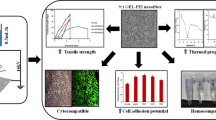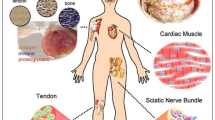Abstract
This study focussed on developing a hybrid P(3HB-co-4HB)/gelatine nanofibre with an enhanced wettability and biocompatibility properties while retaining its desired properties as biodegradable patch for tissue engineering application through electrospinning technique. Both copolymer and gelatine were individually optimized for its concentration, process parameter and voltage. Upon optimization, two versions of hybrid P(3HB-co-4HB)/gelatine nanofibre scaffolds were prepared by layering the copolymer and gelatine, namely PG (double - layer) and PGP (triple - layer). These hybrid scaffolds produced were further crosslink using glutaraldehyde vapour and were characterized for its fibre morphology, wettability, chemical and biological properties. The nanofibre diameter obtained was in between 330 nm to 250 nm for P(3HB-co-4HB) and both hybrid P(3HB-co-4HB)/gelatine. The expression of amino acid, carbonyl group and presence of glutaraldehyde on nanofibre was detected using ATR-FTIR analysis. The PG shows to exhibit better hydrophilic property compared to PGP and P(3HB-co-4HB). However, based on the stability testing was carried out, it revealed that PG has low solution stability compared to PGP which indicates PGP nanofibre scaffolds reaffirms a good water-resistant property. Meanwhile, the MTS assay has shown that mouse fibroblast cell L929 proliferated well on both PG and PGP compared to pure P(3HB-co-4HB) nanofibre scaffolds, evidenced by an increased cell number from 3.04 × 105 cells/mL to 3.37 × 105 cells/mL. The results have collectively shown the incorporation of small amount of fish gelatine has improved the overall properties of hybrid nanofibre scaffolds. The PGP shows the potential candidates for medical application due to its stability property in solution and has comparable property with PG.







Similar content being viewed by others
References
Hubbell JA (2003) Materials as morphogenetic guides in tissue engineering. Curr Opin Biotechnol 14(5):551–558
Khor E, Lim LY (2003) Implantable applications of chitin and chitosan. Biomaterials 24(13):2339–2349. https://doi.org/10.1016/S0142-9612(03)00026-7
Frenot A, Chronakis IS (2003) Polymer nanofibers assembled by electrospinning. Curr Opin Colloid Interface Sci 8:64–75
Zong X, Bien H, Chung CY, Yin L, Fang D, Hsiao BS, Chu B, Entcheva E (2005) Electrospun fine-textured scaffolds for heart tissue constructs. Biomaterials 26(26):5330–5338. https://doi.org/10.1016/j.biomaterials.2005.01.052
Lee Y-F, Sridewi N, Ramanathan S, Sudesh K (2016) The influence of electrospinning parameters and drug loading on polyhydroxyalkanoate (PHA) nanofibers for drug delivery. Int J Biotechnol Wellness Ind 4:103–113. https://doi.org/10.6000/1927-3037.2015.04.04.1
Vigneswari S, Murugaiyah V, Kaur G, Abdul Khalil HPS, Amirul AA (2016) Simultaneous dual syringe electrospinning system using benign solvent to fabricate nanofibrous P(3HB-co-4HB)/collagen peptides construct as potential leave-on wound dressing. Mater Sci Eng C 66:147–155. https://doi.org/10.1016/j.msec.2016.03.102
Siew EL, Rajab NF, Osman AB, Sudesh K, Inayat-Hussain SH (2009) Mutagenic and clastogenic characterization of poststerilized poly(3-hydroxybutyrate-co-4-hydroxybutyrate) copolymer biosynthesized by Delftia acidovorans. J Biomed Mater Res A 91(3):786–794. https://doi.org/10.1002/jbm.a.32290
Siew EL, Rajab NF, Osman AB, Sudesh K, Inayat-Hussain SH (2007) In vitro biocompatibility evaluation of poly(3-hydroxybutyrate-co-4-hydroxybutyrate) copolymer in fibroblast cells. J Biomed Mater Res 81(2):317–325. https://doi.org/10.1002/jbm.a31000
Martin DP, Williams SF (2003) Medical applications of poly-4-hydroxybutyrate : A strong flexible absorbable biomaterial 16(2):97–105. https://doi.org/10.1016/S1369-703X(03)00040-8
Nelson T, Kaufman E, Kline E, Sokoloff L (1981) The extraneural distribution of gamma-hydroxybutyrate. J Neurochem 37(5):1345–1348
Chandrasekaran AR, Venugopal J, Sundarrajan S, Ramakrishna S (2011) Fabrication of a nanofibrous scaffold with improved bioactivity for culture of human dermal fibroblasts for skin regeneration. Biomed Mater 6. https://doi.org/10.1088/1748-6041/6/1/015001
Kathuria N, Tripathi A, Kar KK, Kumar A (2009) Synthesis and characterization of elastic and macroporous chitosan-gelatin cryogels for tissue engineering. Acta Biomater 5:406–418. https://doi.org/10.1016/j.actbio.2008.07.009
Zhang Y, Ouyang H, Lim CT, Ramakrishna S (2005) Electrospinning of gelatin fibers and gelatin/PCL composite fibrous scaffolds. J Biomed Mater Res B Appl Biomater 72:156–165. https://doi.org/10.1002/jbm.b.30128
Zhang YZ, Venugopal J, Huang ZM, Lim CT, Ramakrishna S (2006) Crosslinking of the electrospun gelatin nanofibers. Polymer (Guildf) 47(8):2911–2917. https://doi.org/10.1016/j.polymer.2006.02.046
Gorgieva S, Kokol V (2012) Collagen- vs. Gelatine-Based Biomaterials and Their Biocompatibility: Review and Perspectives. In: R. Pignatello (Ed). Biomaterials Applications for Nanomedicine. In Tech.
Meng W, Xing ZC, Jung KH, Kim SY, Yuan J, Kang IK, Yoon SC, Shin HI (2008) Synthesis of gelatin-containing PHBV nanofiber mats for biomedical application. J Mater Sci Mater Med 19(8):2799–2807. https://doi.org/10.1007/s10856-007-3356-3
Huong KH, Azuraini MJ, Aziz NA, Amirul AA (2017) Pilot scale production of poly(3-hydroxybutyrate-co-4-hydroxybutyrate) biopolymers with high molecular weight and elastomeric properties. J Biosci Bioeng 124:76–83. https://doi.org/10.1016/j.jbiosc.2017.02.003
Syafiq IM, Huong KH, Shantini K, Aziz NA, Amirul AA, Bhubalan K (2017) Synthesis of high 4-hydroxybutyrate copolymer by Cupriavidus sp. transformants using one-stage cultivation and mixed precursor substrates strategy. Enzym Microb Technol 98:1–8. https://doi.org/10.1016/j.enzmictec.2016.11.011
Dong B, Arnoult O, Smith ME, Wnek GE (2009) Electrospinning of collagen nanofiber scaffolds from benign solvents. Macromol Rapid Commun 30(7):539–542. https://doi.org/10.1002/marc.200800634
Ying TH, Ishii D, Mahara A, Murakami S, Yamaoka T, Sudesh K, Samian R, Fujita M, Maeda M, Iwata T (2008) Scaffolds from electrospun polyhydroxyalkanoate copolymers: Fabrication, characterization, bioabsorption and tissue response 29(10):1307–1317. https://doi.org/10.1016/j.biomaterials.2007.11.031
Rennukka M, Amirul AA (2013) Fabrication of poly(3-hydroxybutyrate-co-4-hydroxybutyrate)/chitosan blend material: Synergistic effects on physical, chemical, thermal and biological properties. Polym Bull 70(6):1937–1957. https://doi.org/10.1007/s00289-012-0895-7
Abdul Khalil HPS, Suraya NL (2011) Anhydride modification of cultivated kenaf bast fibers: Morphological, spectroscopic, and thermal studies. BioResources 6:1122–1135
Chee JW, Amirul AA, Tengku Muhammad TS, Majid MIA, Mansor SM (2008) The influence of copolymer ratio and drug loading level on the biocompatibility of P(3HB-co-4HB) synthesized by Cupriavidus sp. (USMAA2-4). Biochem Eng J 38(3):314–318. https://doi.org/10.1016/j.bej.2007.07.018
Vigneswari S, Bhubalan K, Amirul AA (2014) Design and Tailoring of Polyhydroxyalkanoate-Based Biomaterials Containing 4-Hydroxybutyrate Monomer. In book: In: Biotechnology and Bioinformatics: Advances and applications for Bioenergy, Bioremediation and Biopharmaceutical Research. Publisher: Boca Raton: CRC Press
Lyons J, Li C, Ko F (2004) Melt-electrospinning part I: Processing parameters and geometric properties. Polymer (Guildf) 45(22):7597–7603. https://doi.org/10.1016/j.polymer.2004.08.071
Huong K, Mohd Yahya AR, Amirul AA (2014) Pronounced synergistic influence of mixed substrate cultivation on single step copolymer P(3HB-co-4HB ) biosynthesis with a wide range of 4HB monomer composition. J. Chem Technol Biotechnol. 89(7):1023–1029. https://doi.org/10.1002/jctb.4195
Vigneswari S, Majid MIA, Amirul AA (2012) Tailoring the surface architecture of poly(3-hydroxybutyrate-co-4-hydroxybutyrate) scaffolds. J. Appl Polym Sci 124:2777–2788. https://doi.org/10.1002/app.35336
Pham QP, Sharma U, Mikos AG (2006) Electrospinning of polymeric nanofibers for tissue engineering applications: A review. Tissue Eng 12(5):1197–1211. https://doi.org/10.1089/ten.2006.12.1197
Rosso F, Marino G, Giordano A, Barbarisi M, Parmeggiani D, Barbarisi A (2005) Smart materials as scaffolds for tissue engineering. J Cell Physiol 203:465–470
Lee SY, Choi J (2001) Production of microbial polyester by fermentation of recombinant microorganisms. Adv Biochem Eng Biotechnol 71:183–207
Nagiah N, Madhavi L, Anitha R, Srinivasan NT, Sivagnanam UT (2013) Electrospinning of poly(3-hydroxybutyric acid) and gelatin blended thin films: Fabrication, characterization, and application in skin regeneration. Polym Bull 70:2337–2358. https://doi.org/10.1007/s00289-013-0956-6
Zha Z, Teng W, Markle V, Dai Z, Wu X (2012) Fabrication of gelatin nanofibrous scaffolds using ethanol/phosphate buffer saline as a benign solvent. Biopolymers 97(12):1026–1036. https://doi.org/10.1002/bip.22120
Qian YF, Zhang KH, Chen F, Ke QF, Mo XM (2011) Cross-linking of gelatin and chitosan complex nanofibers for tissue-engineering scaffolds. J Biomater Sci Polym Ed 22:1099–1113. https://doi.org/10.1163/092050610X499447
Ghasemi-Mobarakeh L, Prabhakaran MP, Morshed M, Nasr-Esfahani MH, Ramakrishna R (2008) Electrospun poly(Ɛ-caprolactone)/gelatin nanofibrous scaffolds for nerve tissue engineering. Biomaterials 29(34):4532–4539. https://doi.org/10.1016/j.biomaterials.2008.08.007
Safikhani MM, Zamanian A, Ghorbani F, Asefnejab A, Shahrezaee M (2017) Bi-layered electrospun nanofibrous polyurethane-gelatin scaffold with targeted heparin release profiles for tissue engineering applications. J Polym Eng 37(9):785–860. https://doi.org/10.1515/polyeng-2016-0291
Rao U, Sridhar R, Sehgal P.K (2010) Biosynthesis and biocompatibility of poly(3-hydroxybutyrate-co-4-hydroxybutyrate) produced by Cupriavidus necator from spent palm oil. Biochemical Engineering Journal 49: 13–20. https://doi.org/10.1016/j.bej.2009.11.005
Acknowledgements
The author would like to express thanks to Research University Grant (RUI) (Grant number: 1001/PBIOLOGI/811304), USM for their financial support.
Author information
Authors and Affiliations
Corresponding author
Additional information
Publisher’s note
Springer Nature remains neutral with regard to jurisdictional claims in published maps and institutional affiliations.
Rights and permissions
About this article
Cite this article
Azuraini, M.J., Huong, KH., Khalil, H.P.S.A. et al. Fabrication and characterization of P(3HB-co-4HB)/gelatine biomimetic nanofibrous scaffold for tissue engineering application. J Polym Res 26, 257 (2019). https://doi.org/10.1007/s10965-019-1925-z
Received:
Accepted:
Published:
DOI: https://doi.org/10.1007/s10965-019-1925-z




